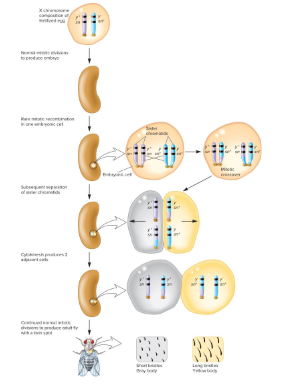Chapter 6 - Linkage
1/39
Earn XP
Name | Mastery | Learn | Test | Matching | Spaced |
|---|
No study sessions yet.
40 Terms
Law of independent assortment
The transmission of genes close to one another on the same chromosome violates which of Mendel’s laws?
Recombination
Fill in the blank…
Genes linked together on the same chromosome usually assort together. Linked genes may become separated by ( ).
Chromosome
In eukaryotic species, linear types of these are comprised of a long piece of DNA that typically contains many hundred or even a few thousand different genes.
Synteny
When two or more genes are located on the same chromosome and are physically linked.
Genetic Linkage
The phenomenon in which genes close together on a chromosome tend to be transmitted as a unit, which influences inheritance patterns.
Linkage Groups
Chromosomes are called these because they contain a group of genes that are linked together. The number of these is the number of types of chromosomes in the species.
Ex) Humans → 22 autosomal groups
Crossing-Over / bivalents / recombinant
Fill in the blank…
Genes that are on the same chromosome may independently assort from each other due to ( ) during prophase 1 of meiosis. During this, replicated sister chromatid homologs associate as ( ) and exchange DNA segments to reassort alleles and produce ( ) genotypes.

9:3:3:1 / parental / linked
Fill in the blank…
Bateson and Punnett conducted a cross in sweet peas involving two different traits: flower color and pollen shape. The expected ( ) ratio in the F2 generation for this two-factor cross was not observed. More of the original ( ) types were observed (homozygous recessive and dominant). This occurred because the genes did not independently assort; rather, the two genes were ( ) on the same chromosome.

Recombinant Offspring
Also called nonparental offspring, these are produced by the exchange of DNA between two homologous chromosomes during meiosis in one or both parents, leading to a novel combination of genetic material.
Recombinant Cells
Haploid cells that contain a combination of alleles not found in the original chromosomes. Also called nonparental cells.
1) Why did the F2 generation have so much recombinant offspring?
2) Why was there a huge difference between the different types of recombinant offspring?
When Thomas Hunt Morgan studied X-linked genes of Drosphilia, he had to answer what two questions based on his results?

F1 / X / homologous / X-linked
Fill in the blank…
Morgan observed that in his F2 generation, there was a higher proportion of combinations of traits found in the ( ) generation (parents). He reasoned that all three genes must be located on the ( ) chromosome and are transmitted together as a unit. To explain the recombinant types, Morgan proposed crossing over between the ( ) X chromosomes and guessed that it did not occur between the X and Y chromosome since the traits were ( ) and the Y chromosome did not contain the three genes.
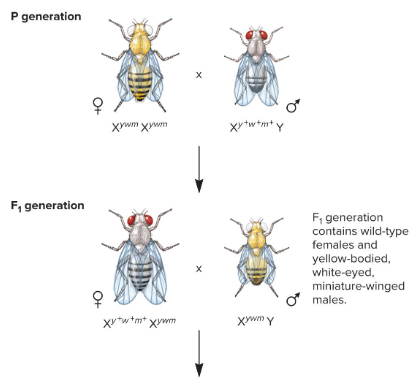
1) The genes for eye color, body color, and wing size were all located on the X-chromosome so their alleles were linked together
2) Due to crossing over, the homologous X chromosomes in the females could exchange information and result in new combinations of alleles
3) The likelihood of crossing over depends on the distance between the two genes and is more likely to occur between two genes that are far apart from each other.
What were Morgan’s three hypotheses to explain his results?
Distance / closer / double
Fill in the blank…
Morgan’s explanation for different proportions of recombinant offspring was that certain cross-overs were more or less common than others due to the ( ) of the two genes. The ( ) two genes were on the chromosomes, the less likely corssing-over was to occur.
He also posited that a ( ) cross-over was very uncommon.
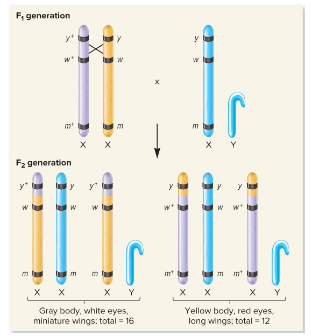
Genetic Mapping
Also called gene mapping or chromosome mapping, this is performed to determine the linear order of linked genes along the same chromosome.
This process allows for understanding the complexity and organization of a particular species, understanding evolutionary relationships among species, diagnosing and possibly treating inherited human diseases, and even helping geneticists to clone genes. It can even be used to predict from crosses which offspring will inherit diseases and even improve agricultural strains.
Many / few
Fill in the blank…
Experimentally, the percentage of recombinant offspring is correlated with the distance between the two genes. Genes that are far apart result in ( ) recombinant offspring while close genes result in ( ) recombinant offspring.
Map Distance
A value that allows one to estimate the relative distances between linked genes. It is found by dividing the number of recombinant offspring by the total number of offspring and multiplying that value by 100. The units are map units or centiMorgans (cM)
One map unit is equivalent to 1% recombination frequency (RF)
Curt Stern
Wanted to obtain direct evidence that genetic recombination is due to crossing over. He studied this by observing the results of crossing-over of X chromosomes in flies.
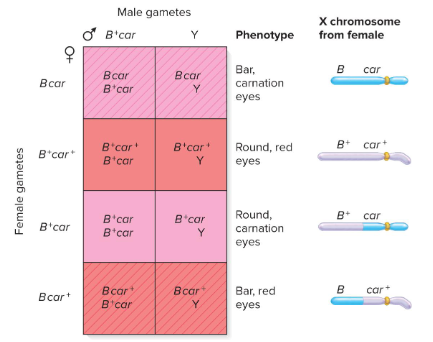
1) Heterozygous for two or more genes
2) Homozygous recessive for the same genes
What two types of organisms are used in a test-cross for genetic mapping?
Limit / 50
Fill in the blank…
Multiple cross-overs set a ( ) on measurable recombination frequencies as the physical distance increases. A test-cross is expected to yield a maximum of only ( )% recombinant offspring.
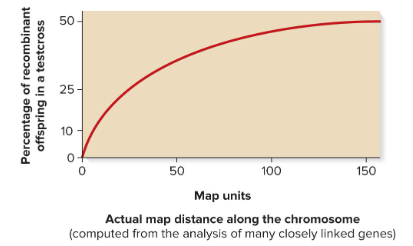
1) Cross two organisms that are homozygous for the three alleles (one homozygous dominant and one homozygous recessive) to produce heterozygotes in the F1 generation
2) Perform the test-cross in which one F1 heterozygote is crossed with a homozygous recessive individual
3) Collect data from the F2 offspring produced.
4) Calculate the map distance between pairs of genes (i.e. regroup data according to pairs of genes…eye color and body color or eye color and wing length or wing length and body color)
5) Construct the gene map based on the calculated map units (higher map distances means greater distances between pairs of genes)
What are the steps for conducting a three-factor test cross?

Eight / independently
Fill in the blank…
If the three genes in a three-factor cross exist as two alleles each, there are ( ) possible combinations of offspring. If the genes assort ( ), all of these combinations would occur in equal proportions.
1) Nonrecombinant phenotypes occur most frequently
2) Double crossover phenotypes occur least frequently
3) Single crossover phenotypes occur with intermediate frequency
What are three general trends in the offspring of crosses involving linked genes?
Double Crossover
A crossover event that separates the gene in the middle from the other two genes at the other end.
Ex) A recessive purple eye color is separated from the other two recessive alleles. Thus, the gene for eye color lies between the genes for body color and wing shape.

Linked / Non-recombinant / recombinant
Fill in the blank…
In a three-factor cross, we know that in the P generation, the dominant alleles are ( ) as well as the recessive alleles. ( ) F2 offspring will have a pair of dominant or recessive alleles while ( ) offspring will have one dominant and one recessive allele.
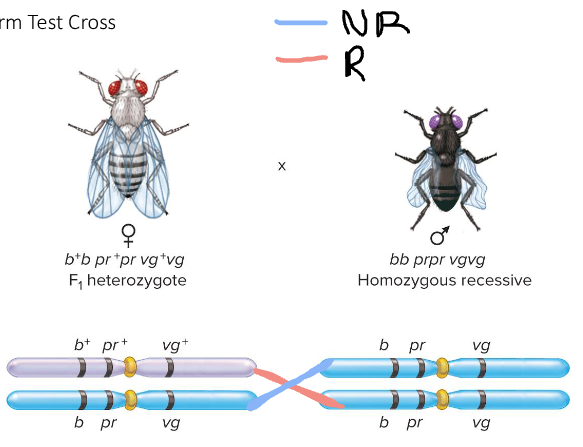
Interference
When the observed number of offspring produced through a double crossover is lower than expected. This occurs when the first crossover decreases the probability that a second crossover will occur nearby.
The product rule in which each probability for a single crossover event is multiplied together. This probability is then multiplied by the total number of offspring.
How do you determine the probability of a double crossover occurring?
Ascomycetes
Sac fungi who have been useful to geneticists because of their unique style of sexual reproduction. The fungi themselves can be unicellular or multicellular organisms, but they are typically haploid.
Tetrad
A group of four spores.

Ascus
A sac that encloses the spores.
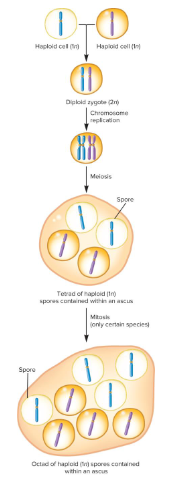
Spores
The haploid cells produced following meiosis.
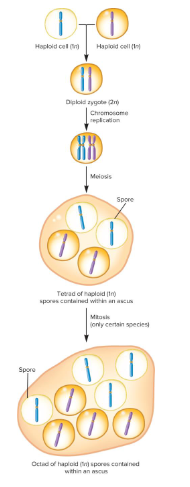
Octads
Groups of eight spores produced following mitotic division.
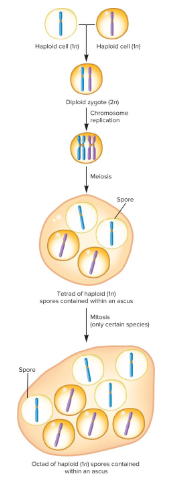
Parental Ditype (PD)
A tetrad formed after meiosis that contains four haploid cells with nonrecombinant arrangements of alleles.
Tetratype (T)
When the ascus contains a tetrad consisting of two nonrecombinant cells and two recombinant cells.
Nonparental Ditype (NPD)
When the ascus/tetrad contains all four spores with recombinant genotypes.
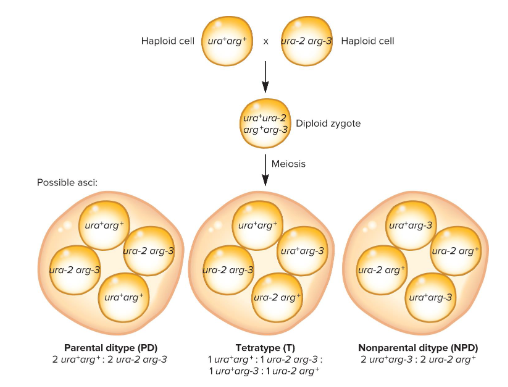
Equal / crossover / parental / tetratype
Fill in the blank…
If the two genes assort independently, the number of asci with a parental ditype is expected to ( ) the number with a nonparental ditype. If the two genes are linked, the type of ( ) between them determines what type of ascus is produced.
1) No crossover → ( ) ditype
2) Single crossover → ( )
3) Double crossover → Any
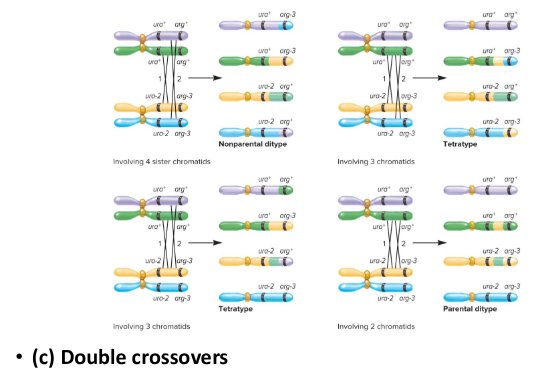
[[Single crossover tetrads + 2(double cross-over tetrads)] / total number of asci] x 0.5 × 100
What is the formula for calculating map distances for tetrads?

Double
A nonparental ditype is always produced from a ( ) crossover.
Mitotic Recombination
The rare occurrence in which a pair of recombinant chromosomes that have a new combination of alleles are produced during mitosis. If it occurs during the early stages of embryonic development, the recombinant daughter cells continue to divide and may result in a patch of tissue with characteristics different from the rest of the organism.
Twin Spot
Places on an organism in which two adjacent regions are different from the rest of the body and from each other. Stern observed this in his female fruit flies and proposed that it was caused by mitotic recombination within one cell during embryonic development.
